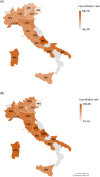Extensive impact of COVID-19 pandemic on pelvic floor dysfunctions care: A nationwide interdisciplinary survey
- PMID: 33492706
- PMCID: PMC8013427
- DOI: 10.1002/nau.24610
Extensive impact of COVID-19 pandemic on pelvic floor dysfunctions care: A nationwide interdisciplinary survey
Abstract
Aims: To investigate the impact of COVID-19 pandemic on health-care provision to patients suffering from pelvic floor dysfunctions in Italy.
Methods: A retrospective web-based interdisciplinary survey was mailed by the Italian Society of Urodynamics to members involved in pelvic floor dysfunctions management from June 22, 2020 to July 17, 2020. The 84-item questionnaire investigated the period March-June 2020 (first epidemic wave) and showed high content validity. The primary outcome was the mean rate of cancellation for health-care services. Secondary outcomes included estimation of the accumulated surgeries backload until return to baseline activity and of the recovery pattern, using linear regression and scenario-based forecasting.
Results: A total of 85 participants provided complete responses. Respondents were mostly urologists (47%), followed by gynecologists (29.5%) and physiatrists (17.6%). On average, 78.4% of outpatient services and 82.7% of functional surgeries were canceled, without significant differences by geographical distribution. An impact on patients' quality of life was anticipated by most of the respondents (87%) and 48.2% also reported potentially serious health risks for patients. Thirty-three percent of the respondents reported the use of telemedicine. If the nation-wide surgical activity increases by 20% postpandemic, it would take 37 months to clear the backlog of functional surgeries. We acknowledge the inherent limitations of the survey methodology and retrospective design.
Conclusions: Access to care for patients suffering from pelvic floor dysfunctions has been dramatically affected by the COVID-19 outbreak. The indirect effects of this unprecedented disruption on pelvic floor dysfunctions care may last for several months.
Keywords: COVID-19 pandemic; benign prostatic hyperplasia; chronic pelvic pain; cystitis; incontinence; overactive bladder; pelvic floor dysfunction; pelvic organ prolapse; perineal fistula.
© 2021 Wiley Periodicals LLC.
Conflict of interest statement
Emilio Sacco: Pierrefabre (financial support for attending symposia and financial support for educational academic courses), Tegea (financial support for educational academic courses). Carlo Gandi: Pierrefabre (financial support for attending symposia), Lolipharma (financial support for attending symposia), Boston Scientific (financial support for attending symposia). Vincenzo Li Marzi: Ferring (speaker honorarium), IBSA (speaker honorarium). Enrico Finazzi Agro': Pierrefabre (speaker honorarium), Laborie (speaker and consultant honorarium), Recordati (speaker honorarium). Gianfranco Lamberti, Maurizio Serati, Marco Soligo: the remaining authors declare that there are no conflict of interests.
Figures




Comment in
-
Geriatrics.J Urol. 2021 Sep;206(3):747-750. doi: 10.1097/JU.0000000000001918. Epub 2021 Jun 17. J Urol. 2021. PMID: 34134523 No abstract available.
References
-
- Italian Ministry of Health. Nuovo coronavirus. 2020. http://www.salute.gov.it/nuovocoronavirus. Accessed August 19, 2020.
-
- Ficarra V, Novara G, Abrate A, et al. Urology practice during COVID‐19 pandemic. Minerva Urol Nefrol. 2020;72(3):369‐375. - PubMed
MeSH terms
LinkOut - more resources
Full Text Sources
Other Literature Sources
Medical

